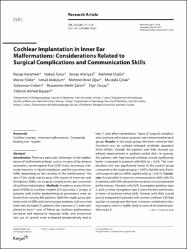| dc.contributor.author | Karamert, Recep | |
| dc.contributor.author | Tutar, Hakan | |
| dc.contributor.author | Altınyay, Şenay | |
| dc.contributor.author | Düzlü, Mehmet | |
| dc.contributor.author | Yıldız, Merve | |
| dc.contributor.author | Akdulum, İsmail | |
| dc.contributor.author | Uǧur, Mehmet Birol | |
| dc.contributor.author | Çolak, Mustafa | |
| dc.contributor.author | Cebeci, Süleyman | |
| dc.contributor.author | Şahin, Muammer Melih | |
| dc.contributor.author | Orçan, Elçin | |
| dc.contributor.author | Bayazıt, Yıldırım Ahmet | |
| dc.date.accessioned | 2022-12-21T07:34:58Z | |
| dc.date.available | 2022-12-21T07:34:58Z | |
| dc.date.issued | 2022 | en_US |
| dc.identifier.citation | Karamert, R., Tutar, H., Altınyay, Ş., Düzlü, M., Yıldız, M., Akdulum, İ. ... Bayazıt, Y. A. (2022). Cochlear implantation in inner ear malformations: Considerations related to surgical complications and communication skills. ORL, 84(3), 211-218. https://doi.org/10.1159/000517562 | en_US |
| dc.identifier.issn | 0301-1569 | |
| dc.identifier.issn | 1423-0275 | |
| dc.identifier.uri | https://doi.org/10.1159/000517562 | |
| dc.identifier.uri | https://hdl.handle.net/20.500.12511/10151 | |
| dc.description.abstract | Introduction: There are particular challenges in the implantation of malformed cochleae, such as in cases of facial nerve anomalies, cerebrospinal fluid (CSF) leaks, erroneous electrode insertion, or facial stimulation, and the outcomes may differ depending on the severity of the malformation. The aim of this study was to assess the impact of inner ear malformations (IEMs) on surgical complications and outcomes of cochlear implantation. Methods: In order to assess the impact of IEMs on cochlear implant (CI) outcomes, 2 groups of patients with similar epidemiological parameters were selected from among 863 patients. Both the study group (patients with an IEM) and control group (patients with a normal inner ear) included 25 patients who received a CI and completed at least 1 year of follow-up. Auditory performance, receptive and expressive language skills, and production and use of speech were evaluated preoperatively and at least 1 year after implantation. Types of surgical complications and rates of revision surgeries were determined in each group. Results: In the study group, the most common malformation was an isolated enlarged vestibular aqueduct (EVA) (44.8%). Overall, the patients with IEMs showed significant improvement in auditory-verbal skills. In general, the patients who had normal cochleae scored significantly better compared to patients with IEMs (p < 0.05). The complication rate was significantly lower in the control group compared to the study group (p = 0.001), but the rate of revision surgeries did not differ significantly (p = 0.637). Conclusion: It is possible to improve communication skills with CIs in patients with IEMs despite the variations in postoperative performances. Patients with EVA, incomplete partition type 2, and cochlear hypoplasia type 2 were the best performers in terms of auditory-verbal skills. Patients with IEMs scored poorly compared to patients with normal cochleae. CSF leak (gusher or oozing) was the most common complication during surgery, which is highly likely in cases of incomplete partition type 3. | en_US |
| dc.language.iso | eng | en_US |
| dc.publisher | S. Karger AG | en_US |
| dc.rights | info:eu-repo/semantics/openAccess | en_US |
| dc.subject | Cochlear Implant | en_US |
| dc.subject | Inner Ear Malformation | en_US |
| dc.subject | Congenital Hearing Loss | en_US |
| dc.subject | Gusher | en_US |
| dc.title | Cochlear implantation in inner ear malformations: Considerations related to surgical complications and communication skills | en_US |
| dc.type | article | en_US |
| dc.relation.ispartof | ORL | en_US |
| dc.department | İstanbul Medipol Üniversitesi, Tıp Fakültesi, Cerrahi Tıp Bilimleri Bölümü, Kulak Burun Boğaz Hastalıkları Ana Bilim Dalı | en_US |
| dc.authorid | 0000-0002-3887-4569 | en_US |
| dc.identifier.volume | 84 | en_US |
| dc.identifier.issue | 3 | en_US |
| dc.identifier.startpage | 211 | en_US |
| dc.identifier.endpage | 218 | en_US |
| dc.relation.publicationcategory | Makale - Uluslararası Hakemli Dergi - Kurum Öğretim Elemanı | en_US |
| dc.identifier.doi | 10.1159/000517562 | en_US |
| dc.institutionauthor | Bayazıt, Yıldırım Ahmet | |
| dc.identifier.wosquality | Q3 | en_US |
| dc.identifier.wos | 000696334100001 | en_US |
| dc.identifier.scopus | 2-s2.0-85115628672 | en_US |
| dc.identifier.pmid | 34500448 | en_US |
| dc.identifier.scopusquality | Q2 | en_US |


















